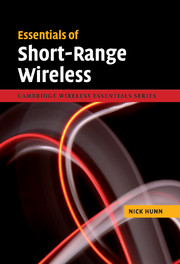Refine search
Actions for selected content:
6790 results in Communications and signal processing
References
-
- Book:
- Graph Spectra for Complex Networks
- Published online:
- 01 March 2011
- Print publication:
- 02 December 2010, pp 339-344
-
- Chapter
- Export citation
10 - Orthogonal polynomials
-
- Book:
- Graph Spectra for Complex Networks
- Published online:
- 01 March 2011
- Print publication:
- 02 December 2010, pp 313-338
-
- Chapter
- Export citation
3 - Eigenvalues of the adjacency matrix
-
- Book:
- Graph Spectra for Complex Networks
- Published online:
- 01 March 2011
- Print publication:
- 02 December 2010, pp 29-66
-
- Chapter
- Export citation
Part I - Spectra of graphs
-
- Book:
- Graph Spectra for Complex Networks
- Published online:
- 01 March 2011
- Print publication:
- 02 December 2010, pp 11-12
-
- Chapter
- Export citation
6 - Density function of the eigenvalues
-
- Book:
- Graph Spectra for Complex Networks
- Published online:
- 01 March 2011
- Print publication:
- 02 December 2010, pp 159-178
-
- Chapter
- Export citation
4 - Eigenvalues of the Laplacian Q
-
- Book:
- Graph Spectra for Complex Networks
- Published online:
- 01 March 2011
- Print publication:
- 02 December 2010, pp 67-114
-
- Chapter
- Export citation
Frontmatter
-
- Book:
- Graph Spectra for Complex Networks
- Published online:
- 01 March 2011
- Print publication:
- 02 December 2010, pp i-iv
-
- Chapter
- Export citation
Contents
-
- Book:
- Graph Spectra for Complex Networks
- Published online:
- 01 March 2011
- Print publication:
- 02 December 2010, pp v-viii
-
- Chapter
- Export citation
2 - Algebraic graph theory
-
- Book:
- Graph Spectra for Complex Networks
- Published online:
- 01 March 2011
- Print publication:
- 02 December 2010, pp 13-28
-
- Chapter
- Export citation
Preface
-
- Book:
- Graph Spectra for Complex Networks
- Published online:
- 01 March 2011
- Print publication:
- 02 December 2010, pp ix-xii
-
- Chapter
- Export citation
Index
-
- Book:
- Graph Spectra for Complex Networks
- Published online:
- 01 March 2011
- Print publication:
- 02 December 2010, pp 345-346
-
- Chapter
- Export citation

Essentials of Short-Range Wireless
-
- Published online:
- 10 November 2010
- Print publication:
- 08 July 2010
Contents
-
- Book:
- Theory and Design of Digital Communication Systems
- Published online:
- 05 June 2012
- Print publication:
- 28 October 2010, pp vii-xvi
-
- Chapter
- Export citation
Preface
-
- Book:
- Filter Bank Transceivers for OFDM and DMT Systems
- Published online:
- 05 August 2015
- Print publication:
- 28 October 2010, pp xi-xii
-
- Chapter
- Export citation
10 - Minimum redundancy FIR transceivers
-
- Book:
- Filter Bank Transceivers for OFDM and DMT Systems
- Published online:
- 05 August 2015
- Print publication:
- 28 October 2010, pp 291-322
-
- Chapter
- Export citation
19 - Optimal strategies for stimulation of cooperation
- from Part III - Securing mechanism and strategies
-
- Book:
- Cognitive Radio Networking and Security
- Published online:
- 06 December 2010
- Print publication:
- 28 October 2010, pp 468-495
-
- Chapter
- Export citation
2 - Preliminaries of digital communications
-
- Book:
- Filter Bank Transceivers for OFDM and DMT Systems
- Published online:
- 05 August 2015
- Print publication:
- 28 October 2010, pp 9-32
-
- Chapter
- Export citation
7 - Demodulation
-
- Book:
- Theory and Design of Digital Communication Systems
- Published online:
- 05 June 2012
- Print publication:
- 28 October 2010, pp 305-431
-
- Chapter
- Export citation
7 - Precoded OFDM systems
-
- Book:
- Filter Bank Transceivers for OFDM and DMT Systems
- Published online:
- 05 August 2015
- Print publication:
- 28 October 2010, pp 193-222
-
- Chapter
- Export citation
8 - Transceiver design with channel information at the transmitter
-
- Book:
- Filter Bank Transceivers for OFDM and DMT Systems
- Published online:
- 05 August 2015
- Print publication:
- 28 October 2010, pp 223-258
-
- Chapter
- Export citation
